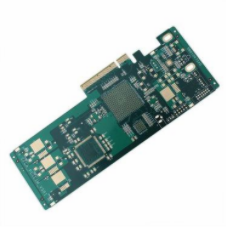How do different electroplating products compare in terms of PCB urgent proofing PCB conductor loss and insertion loss? By manufacturing circuits with different types of transmission lines on some standard PCB laminates and using different plating layers, the effects of different finishes on insertion loss can be compared through measurement and computer simulation.
For example, the GCPW transmission line is on the Ro400 3C hole laminate board that is urgently proofed by PCB. The measurement results show that the microstrip loss of the bare copper strip is much smaller than the microstrip loss with EnIG smoothness. However, the measurement results also show that compared with bare copper, GCW has more loss differences compared with GNCW and EnIG.
4-layer immersion gold board
When preparing circuits of different thicknesses (6.6, 10, and 30 mils) on RO4350B laminates for rapid proofing of PCBs, the total insertion loss tends to be less for thicker materials. Thinner circuits are more mainly affected by conductor loss than other losses, and for each coating finish, it will increase the loss of PCB conductors.

When another circuit material was evaluated in these plating tests and simulations, a 5ML-thick Rt/DuoIL6002 circuit laminate using rolled copper was found to be higher than MI for microstrip circuits with MI-plated copper conductors Conductor loss. Tests are performed on bare copper conductors at a frequency of 40 GHz. When evaluating the solder mask of PCB expedited proofing circuit materials, the microstrip circuit with bare copper conductors showed considerably less loss than copper conductors with solder masks.
Have you understood the differences between PCB multi-layer boards and double-sided PCB boards?
As electronic products have higher and higher requirements for functions, the structure of PCB circuit boards has become more and more complex, from single-layer to double-layer to multilayer, gradually "evolving".
Multilayer board is a printed circuit board formed by laminating and combining alternating conductive pattern layer and insulating material. The number of layers of the conductive pattern is more than three, and the layers are electrically interconnected through metallized holes. If one double-sided board is used as the inner layer, two single-sided boards are used as the outer layer, or two double-sided boards are used as the inner layer, and two single-sided boards are laminated on the outside and interconnected with conductive patterns, a four-layer, PCB can be made Six-layer printed circuit board, also known as multi-layer multi-layer circuit board.
The production process is to first blacken the inner plate pattern, add a semi-cured layer to laminate according to the predetermined design, and then add a piece of copper foil on each of the upper and lower surfaces, and send it to the press to heat and press to obtain the finished product. The "double-sided copper clad laminate" into the inner layer is then CNC drilled according to the pre-designed positioning system. After the hole is drilled, the hole wall shall be etched and de-drilled pollution treatment, and then processed in accordance with the process of double-sided plating of the printed circuit board.
Compared with the production process of PCB double-sided boards, the main difference of multilayer boards is the addition of several unique process steps: inner layer imaging and blackening, lamination, depression and de-drilling pollution. The same machining process also has certain differences in terms of process parameters, equipment accuracy and complexity. For example, the quality requirement of the multi-layer board hole wall is relatively high, and the quality requirement of the double-layer board hole wall is relatively high. In addition, the number of layers drilled each time, the speed and feed rate of the multi-layer board, and the difference of the double-layer board. The inspection of finished products and semi-finished products is also stricter and more complicated than double-sided inspection.